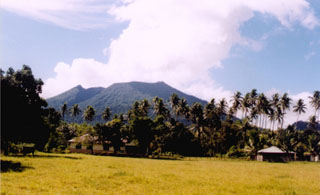Report on Ibu (Indonesia) — 31 July-6 August 2024
Smithsonian Institution / US Geological Survey
Weekly Volcanic Activity Report, 31 July-6 August 2024
Managing Editor: Sally Sennert.
Written by JoAnna G. Marlow.
Please cite this report as:
Global Volcanism Program, 2024. Report on Ibu (Indonesia) (Marlow, J G, and Sennert, S, eds.). Weekly Volcanic Activity Report, 31 July-6 August 2024. Smithsonian Institution and US Geological Survey.
Ibu
Indonesia
1.488°N, 127.63°E; summit elev. 1325 m
All times are local (unless otherwise noted)
Pusat Vulkanologi dan Mitigasi Bencana Geologi (PVMBG) reported that explosive activity continued at Ibu during 31 July-6 August. Emissions were observed daily; white plumes rose as high as 700 m above the summit and gray plumes produced by explosion events rose as high as 1.5 km above the summit. Seismicity included harmonic tremor episodes, volcanic earthquakes, frequent gas emission signals, and 43-108 daily explosion events. Ashfall was reported at the Ibu Volcano Observation Post (9 km W) on 6 August. The Alert Level remained at 3 (the third level on a four-level scale) and the public was advised to stay 4 km away from the active crater and 5 km away from the N crater wall opening.
Geological Summary. The truncated summit of Gunung Ibu stratovolcano along the NW coast of Halmahera Island has large nested summit craters. The inner crater, 1 km wide and 400 m deep, has contained several small crater lakes. The 1.2-km-wide outer crater is breached on the N, creating a steep-walled valley. A large cone grew ENE of the summit, and a smaller one to the WSW has fed a lava flow down the W flank. A group of maars is located below the N and W flanks. The first observed and recorded eruption was a small explosion from the summit crater in 1911. Eruptive activity began again in December 1998, producing a lava dome that eventually covered much of the floor of the inner summit crater along with ongoing explosive ash emissions.
Source: Pusat Vulkanologi dan Mitigasi Bencana Geologi (PVMBG, also known as CVGHM)

